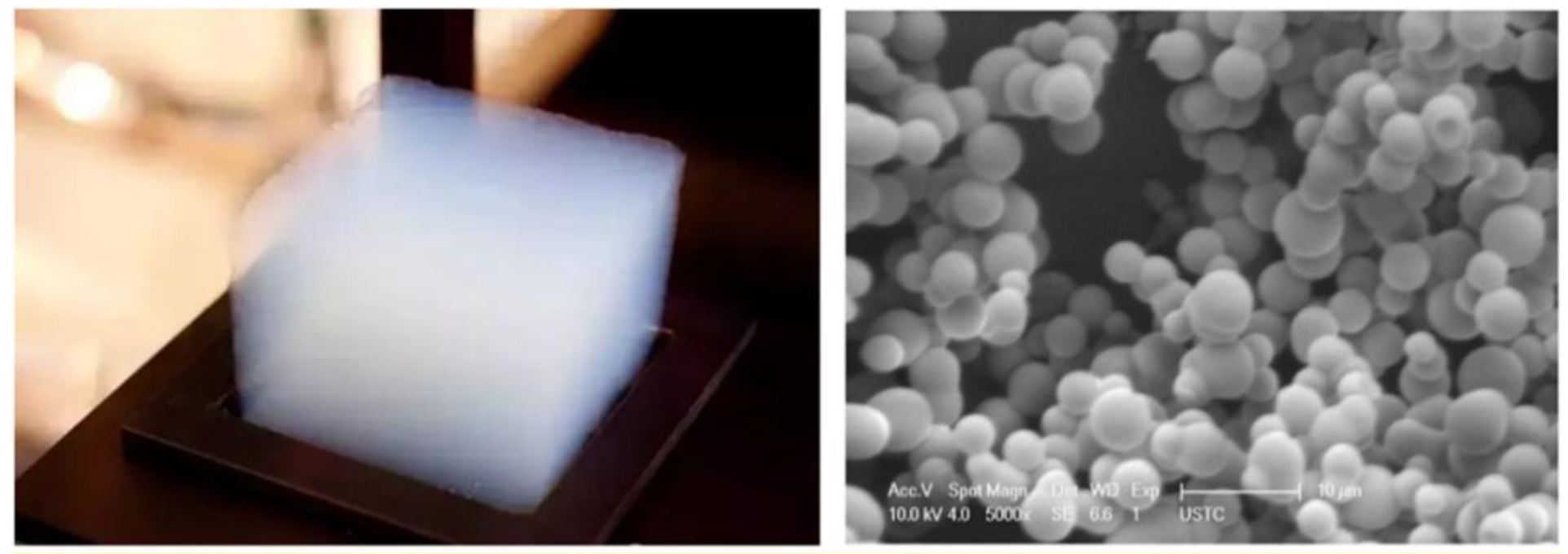Knowledge of Aerogel
Jan 21,2022
In the memory of Dr. Samuel Stephens Kistler
Currently, it is generally accepted in the scientific community that aerogel was invented in 1931. This is because the first paper on aerogels was published by Samuel Stephens Kistler in 1931 in the Journal Nature (vol. 127, p. 741) under the title <Coherent expanded aerogels and jellies>. Thus, 1931 is regarded as the year when aerogels were born.
However, when and where the first piece of aerogel was created by Dr. Kistler, there is still no conclusion.

Dr.Kistler(Right) and Dean of Pacific Academy(Left)
There is also a widespread allusion to the birth of aerogel, which originated from a bet between Kistler and Charles Learned - to see who could replace the liquid in the gel with a gas without changing the solid structure.

Preparation of aerogel
It is an all-known fact that if the liquid in a gel is separated from the solid by direct evaporation, the strong capillary forces will inevitably lead to shrinkage and structural collapse of the solid. After continuous exploration, Kistler finally solved this world problem perfectly by using alcohol supercritical drying technology. In this way, the world's first aerogel, silica aerogel, was born.
Name of "Aerogel"
There is still an unsolved mystery about the birth of aerogel: How did the word aerogel come about? The usual explanation is that aerogel is a combination of two words, aero and gel. Aero, an adjective that means flying, and gel, which literally means "flying gel". Any material gel, as long as the special process of drying to remove the internal solvent, and can basically maintain its shape, and the product of high porosity with low density, it can float in the air, so can be called aerogel.
Then, is the term aerogel named by Dr. Kistler in a flash, or did he hear it from someone else? Did he have other names in mind at the time? This has been lost in history.

Flying gel - Aerogel in Aerospace
At present, Aerogel
Aerogel is a solid material form and the world's least dense solid, known as "frozen smoke", "blue smoke". It has been hailed by Science magazine as "the miracle material that can change the world".
Aerogel has achieved 15 worlds' best records with specialities of very low density, very small pore size, very low insulation coefficient, and very low sound transmission speed. At the same time, aerogel, as a general term for a class of materials, has been prepared one after another by the researchers. At the same time, aerogels are easy to process and have various forms. In summary, aerogels can be used in a wide range of applications, from aerospace, military and other demanding high-tech fields to industrial, transportation and commodity fields.

Common and microscopic of aerogel
Aerogel, a Magic Legacy
In the early 1940s, Kistler entered into a license agreement with Monsanto Corp. for the production of silica aerogel in order to make the aerogel material more widely available. Since then, Monsanto began production at a plant in Everett, Massachusetts, under the names 「Santocel」, 「Santocelc-c"」, 「Santocel-54」 and 「Santocelz-z」, and sold some of them, but due to the high price, the market at that time was difficult to accept, and Monsanto's aerogel project was aborted.
In 1952, Dr. Kistler left the Monsanto Corp. to return to the university campus as dean of the College of Engineering at Utah State University. During this time, Kistler devoted himself to teaching and research, and according to the University of Utah's biographical data on Kistler, Kistler has more than 60 patents and has served as a special consultant to several advanced development companies.
Dr. Kistler has donated licensing fees from his research and development to the University of Utah College of Engineering to fund new projects and special projects that could not be funded through traditional channels, and has purchased many special pieces of equipments for the College. Through his continued efforts, Dr. Kistler has made the College of Engineering one of the most prestigious engineering schools in the country.

University of Utah College of Engineering
Dr. Kistler, a superstar of material scientist, passed away in Salt Lake City in November 1975. Kistler's illustrious and legendary life was marked by outstanding contributions from chemistry and engineering to education, from science policy to world affairs. Sadly, Kistler did not live to see the rise of aerogel materials industry. However, history is fair, as the magic legacy of the late last century - aerogel, come into the people's vision, many fields of application gradually expanded, is becoming aerospace, construction, petrochemical, military, thermal engineering, transportation and household appliances and other fields of insulation materials of choice.

Dr. Kistler in his later years when researching




